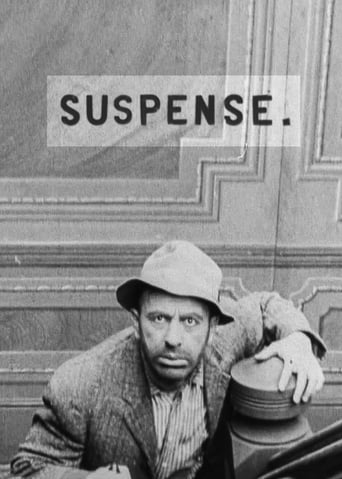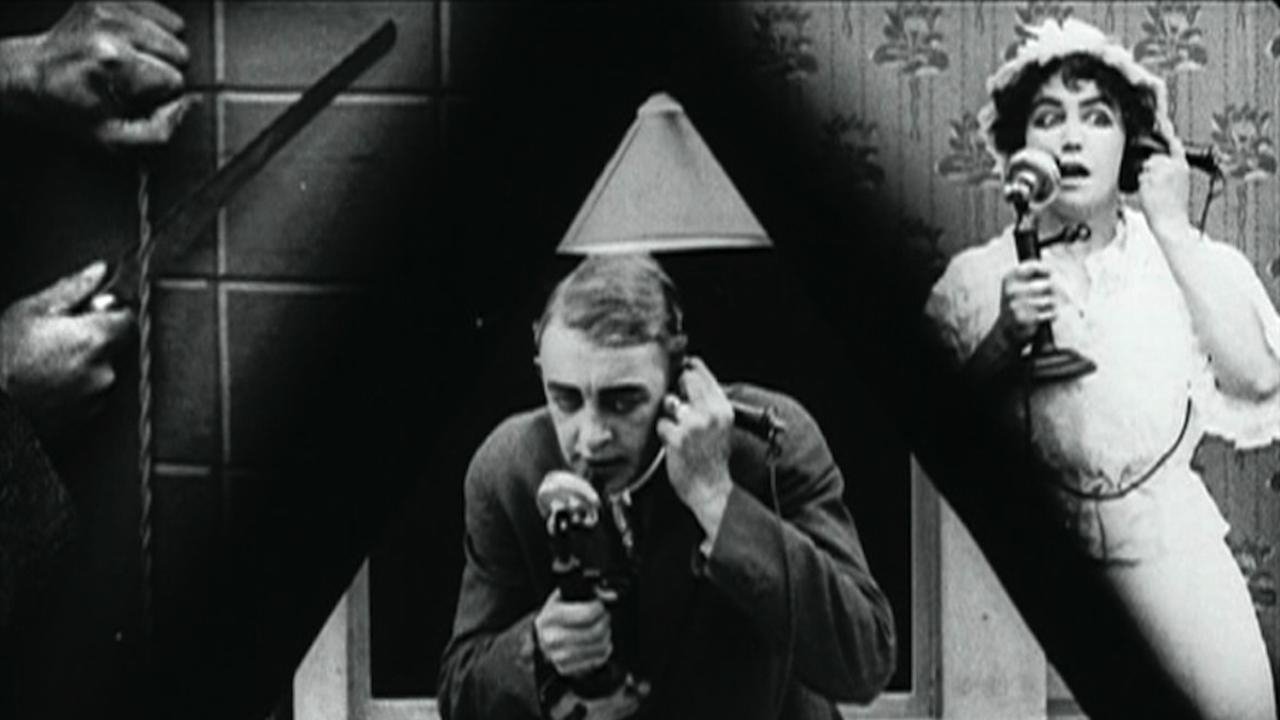kidboots
In 1909 Edwin S. Porter left Edison studios to found Rex but it's most famous film "Suspense" was probably directed by it's two leading players - Lois Weber and Phillips Smalley. Smalley was a Griffith devotee who while trying to make a film along the lines of "The Unseen Enemy" included all his master's innovations - close ups, travelling shots, high camera angles, then hit on an innovation of his own - the triptych!!A servant leaves - refusing to stay in such an isolated place, through the keyhole the mother is seen playing blissfully with the baby. Later, finding the maid's note she looks out of the window and down at the face of a tramp (Douglas Gerrard) who stares menacingly into the face of the camera. She rings her husband who appears as part of a triptych - the other image shows the tramp entering the house.The husband is having troubles of his own - while desperately trying to get to his wife and baby, his car is stolen and while the stolen car is the main focus of the scene, the police and husband in pursuit can be seen on the dim horizon. In another unusual camera shot, the husband can be seen gaining ground through the stolen car's rear view mirror.According to Thomas Gunning "no film made before World War 1 shows stronger command of film style and even out does Griffith for emotionally involved film making"!!!
Red-Barracuda
As the title may give away this film is a very early example of the suspense thriller. In it a woman is terrorised by a malevolent tramp. He stalks her while she is trapped helplessly in her house with her child. Her husband rushes to the rescue with the police in hot pursuit of him for stealing a car to race home.It's a tight and well constructed film. It has very well paced editing that alternates from the scene in the house and the high speed car chase. It's shot with some skill too, with some inventive shots. There is a dynamic action shot taken from a moving car, including some stylish shots of the pursuers in the rear view mirror. Given the primitive equipment in those days this is pretty impressive. It also makes great use of the triptych split-screen effect which allows us to see three separate scenes simultaneously, conveying a lot of information simultaneously. This is one of the first examples of this technique. The feel of the film is a good combination of fast action and a brooding menace.The main creative force behind all of this is Lois Weber, who also starred as the woman in distress. There are hardly any women film directors nowadays - which seems pretty outrageously sexist – Lois Weber was one of the very first though, so can be considered an important pioneer. Although, her gender aside, this remains a good film for its time.
Cineanalyst
Lois Weber was one of the most interesting filmmakers of the 1910s and early 1920s, and despite being one of the most successful directors during that period, she is now largely neglected in the history books and by many silent film enthusiasts. This film of hers "Suspense" is only one of seven I've seen available on home video (as of yet). In 1996, Anthony Slide ("Lois Weber: The Director Who Lost Her Way in History") said that only a dozen or so of her films survive, which according to IMDb is out of the 132 pictures she directed. Regardless, it's a shame that such features of hers as "Discontent", "The Dumb Girl of Portici", "Shoes" (all 1916), "To Please One Woman" (1920) and "What's Worth While?" (1921) which exist aren't more accessible. It's no consolation that the films of many of Weber's contemporaries suffer worse fates.Weber specialized in producing social-problem dramas, or message films. "Suspense", however, is the only film of hers that I've seen which did not sermonize. It's a straightforward entry in the genre of last-minute rescue, action-suspense pictures made especially popular in the Nickelodeon age by D.W. Griffith, with such one-reelers as "The Lonely Villa" (1909), "The Lonedale Operator" (1911), "An Unseen Enemy" and "The Girl and Her Trust" (both 1912). Kevin Brownlow said that "Suspense" more specifically took from and one-upped the plot of Griffith's "A Woman Scorned" (1911). Indeed, the editing of "Suspense" is as fluid as in any of Griffith's short films, and Weber uses some novel camera perspectives that Griffith and his cinematographer Billy Bitzer never had."Suspense" isn't quite as fast paced as Griffith's last-minute rescue films, or probably as hectic as the Keystone parodies of them, such as "The Bangville Police" and "Barney Oldfield's Race for a Life" (both 1913). I roughly counted 46 shots in "Suspense", which would be approximately just fewer than five shots per minute or 15.5 feet of film per shot. On the other hand, Griffith's "An Unseen Enemy", with about 119 shots, has approximately seven shots per minute or an average shot length of 8.4 feet. Even Griffith's earlier picture "The Lonely Villa" I counted to have about six shots per minute. Some of my numbers might be a bit off, but they give you a general idea: Weber's film is slower than Griffith's films. This isn't a weakness, though; the somewhat not as fast pace allows for a different tension over whether the husband speeding in a stolen car and chased by police will rescue his wife before the slowly approaching tramp reaches her, and it allows more time to capture the advanced viewpoints of Weber's camera. Moreover, the crosscutting, matching and rapid succession of shots is excellent."Suspense" is a surprisingly advanced film for 1913, especially in regards to the camera angles. The oft-mentioned triptych shots had already been used in the Danish "The White Slave Trade" films (Den hvide slavehandel) (1910)--also for telephone conversations. The shot of the tramp where he approaches and passes nearby the camera for a close-up while climbing the staircase was borrowed from Griffith's "The Musketeers of Pig Alley" (1912). More original perspectives in "Suspense" include the overhead angles and mirror reflections. Overhead angles are employed when the tramp enters the home, such as one point-of-view shot from the perspective of the housewife (played by the director) looking down from a window, which menacingly catches the tramp looking back at her and thus the camera. A mirror shot in the bedroom shows the wife's reflection in frame before she enters it. Rearview mirror reflections show the police approaching the stolen car of the husband as he races home. Clearly, Weber thoughtfully considered and executed the perspectives of her camera views, as relating to the characters or the audience, and the connectivity and rhythm of the shots placed together. Quite exceptional for a generic one-reel plot.
F Gwynplaine MacIntyre
I viewed a print of 'Suspense' in the National Film Archives, in London. Phillips Smalley is credited as director, but the film was probably co-directed by Lois Weber. Women film directors have always been a rarity, although Alice Guy Blache was also directing films in early silent days. Lois Weber's career is especially interesting because (unlike Mme Guy Blache, who directed from behind the camera), Weber played the lead roles in her own films, directing herself.'Suspense' reminds me of a couple of early DW Griffith films in which a young woman (or a pair of young women), alone in an isolated location, is in jeopardy. We have a similar situation here. Lois Weber plays a young wife in an isolated house. She and her infant are unexpectedly left alone by her husband when the maid has abruptly given notice, leaving her latchkey under the doormat. A passing tramp discovers the situation and tries to break in. When the woman rings her husband (are there no police?), the distress call is terminated when the tramp cuts the 'phone line. The husband, rushing home to rescue his wife and child (are there no police?), steals a motorcar. NOW there are police, as a cop nabs the husband for grand theft auto. Rather than explaining that his wife is in danger, he gives the cop the slip.SPOILERS NOW. The tramp, meantime, has found the maid's latchkey and he lets himself into the house. Just when things look grimmest for Wifey and her child, the cops arrive ... not to nick the tramp, but because they've been pursuing the husband all the way here. Only when the tramp is safely nabbed does the husband finally explain himself.I was eager to view 'Suspense' partly because I'm very interested in Lois Weber's career -- she proves herself a decent actress (by silent standards) and a fine director (ditto) -- but my primary interest in this film is because I was told that the tramp in this film was played by an actor who *might* be Lon Chaney. After viewing 'Suspense', I determined that the villainous tramp in this brief film is definitely NOT the Man of a Thousand Faces. However, there is a brief appearance by another tramp during the chase sequence: this actor wears realistic beard growth and an application of grime, and does indeed appear to be Chaney.'Suspense' is well-acted, quite well-directed and brilliantly edited, with some impressive cross-cutting and even a triptych split-screen effect. It's a shame that the plot line is so contrived, but despite some plausibility issues 'Suspense' is most definitely suspenseful. I'll rate this movie 8 in 10, and I wish that Lois Weber were better known.


 AD
AD

